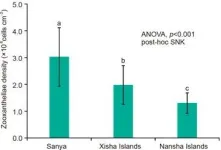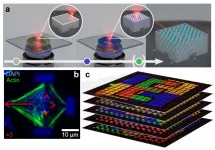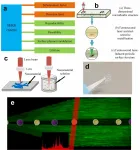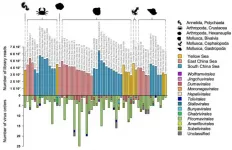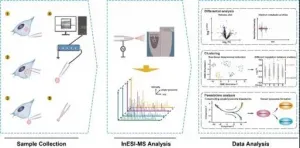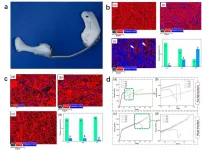New tools for pandemic prevention research: DNA sequencing from water and leech
2021-06-28
(Press-News.org) In a new scientific investigation headed by the German Leibniz Institute for Zoo and Wildlife Research (Leibniz-IZW), water from African and Mongolian waterholes as well as bloodmeals from Southeast Asian leeches were assessed for the ability to retrieve mammalian viruses without the need to find and catch the mammals. The scientists analysed the samples using high throughput sequencing to identify known viruses as well as viruses new to science. Both approaches proved to be suitable tools for pandemic prevention research as they allow finding and monitoring reservoirs of wildlife viruses. For example, a novel coronavirus most likely associated with Southeast Asian deer species was identified. The results are published in the scientific journal "Methods in Ecology and Evolution".
Finding and monitoring reservoirs of wildlife viruses such as SARS-CoV-2 - for which the reservoir has yet to be discovered - is challenging. Many areas which wildlife inhabit are difficult to access and the species in question are hard to find or catch. In order to prevent future pandemics such as COVID-19, new and effective methods to discover and monitor viruses circulating in wildlife are urgently needed. Environmental DNA (eDNA) and invertebrate-derived DNA (iDNA) based approaches may enhance the available toolkit to overcome these challenges, when coupled with high throughput sequencing. The team of scientists assessed water from African and Mongolian waterholes and bloodmeals from Southeast Asian leeches for the ability to retrieve viruses from both sample types. The usual limitation of such samples is that they contain only tiny amounts of low-quality DNA, particularly pathogen DNA. The author therefore used a modern "hybridisation capture" approach to fish out sequences similar to those from currently known vertebrate viruses and then sequenced them using sophisticated high-throughput techniques. This approach was successful in that it allowed the identification of known and novel viruses in both water and leech samples.
The DNA from water samples yielded several viruses common to zebras and wild ass, which were expected as these animals frequently visit the waterholes in large numbers. In the case of the viruses found in African water holes, the authors demonstrated in a related publication that the viruses are still infectious, suggesting that the water itself may be a source of viral transmission. From the Southeast Asian leeches, many known as well as novel viruses were identified. Of particular interest was a novel coronavirus previously unknown to science, which potentially represents an entirely new genus in the Coronaviridae family and seems to be associated with deer species.
"For many of the deadliest viruses such as Ebola we still don't know where they come from", says Prof Alex Greenwood, head of the Department of Wildlife Diseases. "The current pandemic demonstrates that we still know very little about the viral diversity in nature. New methods might help us to identify novel viruses and their potential hosts without the usual logistical and ethical problems associated with collecting wildlife samples directly." Environmental DNA is proving useful in a number of contexts including the characterisation of the diversity of wildlife species from inaccessible regions, the study of ancient populations and more recently in pathogen research. Environmental DNA from water and DNA derived from blood-sucking invertebrates can be useful in different environments. "Water is an essential resource for life and, particularly in areas of seasonal shortages, a concentration point for animals", Greenwood says.
"Terrestrial leeches are often highly abundant in areas of previous viral emergence in Southeast Asia and their bloodmeals can be used to identify their mammalian hosts, including the pathogens contained in their blood", adds Dr Niccolò Alfano, a former PostDoc from the Leibniz-IZW Departments of Wildlife Diseases and Ecological Dynamics, now working at the University of Pavia in Italy. "We identified mammalian viruses from five different viral families in our leech samples and more than 50 % of the samples contained mammalian viruses. Some of these, such as a porcine circovirus or a bear annellovirus could be assigned to the bearded pig and sun bear, their mammalian hosts which were also detected in the leech samples. Most interesting was the discovery of the novel coronavirus, as this showed that with our method we are able to discover viral pathogens previously unknown to science circulating in wildlife", Alfano adds. This may help to identify potentially infectious viruses at an early stage which may help to prevent potential future epidemics."
Further work will be needed to characterise the newly discovered viruses, such as sequencing their complete genomes and confirming their host-virus relationships. In addition, waterholes or leeches are not found in all environments. Soil, faeces and other invertebrates represent additional sources of nucleic acids that could be used to supplement direct animal sampling and enhance our ability to discover and monitor viruses as we go forward from the current pandemic and hopefully learn to prevent them in the future.
INFORMATION:
Publication
Alfano N, Dayaram A, Axtner, J. Tsangaras, K. Kampmann, M.-L., Mohamed, A., Wong, S.T., Gilbert, M.T.P. Wilting, A., Greenwood, A. D. (2021). Non-invasive surveys of mammalian viruses using environmental DNA. METHODS ECOL EVOL, doi:10.1111/2041-210X.13661
Contacts
Leibniz Institute for Zoo and Wildlife Research (Leibniz-IZW)
in the Forschungsverbund Berlin e.V.
Alfred-Kowalke-Str. 17, 10315 Berlin
_ Prof Alex Greenwood
Head of the Department of Wildlife Diseases
phone: +49 (0)30 5168255
e-mail: greenwood@izw-berlin.de
_ Dr Niccolò Alfano
Former PostDoc in the Department of Ecological Dynamics
phone: +393803914437
e-mail: niccolo.alfano@gmail.com
_ Jan Zwilling
Science Communication
phone: +49 (0)30 5168121
e-mail: zwilling@izw-berlin.de
[Attachments] See images for this press release:
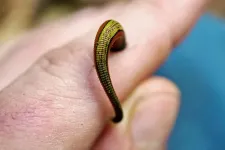
ELSE PRESS RELEASES FROM THIS DATE:
2021-06-28
An international research team led by HKUST has developed a simple but robust blood test from Chinese patient data for early detection and screening of Alzheimer's disease (AD) for the first time, with an accuracy level of over 96%.
Currently, doctors mainly rely on cognitive tests to diagnose a person with AD. Besides clinical assessment, brain imaging and lumbar puncture are the two most commonly used medical procedures to detect changes in the brain caused by AD. However, these methods are expensive, invasive, and frequently unavailable in many countries.
Now, a team led by Prof. Nancy IP, Vice-President for Research and Development at HKUST, has identified 19 out of the 429 plasma proteins associated with AD to form ...
2021-06-28
University of Otago, New Zealand, and UK researchers have developed a world-first weight-loss device to help fight the global obesity epidemic.
DentalSlim Diet Control is an intra-oral device fitted by a dental professional to the upper and lower back teeth. It uses magnetic devices with unique custom-manufactured locking bolts. It allows the wearer to open their mouths only about 2mm, restricting them to a liquid diet, but it allows free speech and doesn't restrict breathing.
Participants in a Dunedin-based trial lost an average of 6.36kg in two weeks and were motivated to continue with their weight loss ...
2021-06-28
Coral bleaching and the ecological degradation of coral reefs have become increasingly severe due to the global warming and human activities. As "mixotrophic" organisms, scleractinian coral can not only obtain energy through photosynthesis of symbiotic zooxanthellae (autotrophy), but also ingest nutrients in seawater through the coral host (heterotrophy). However, the influence of coral's trophic flexibility on environmental adaptability remains unclear. Coral reefs are widely distributed in the South China Sea (SCS), spanning about 20 latitudes from north to south. The environmental conditions of coral reef areas at different latitudes are significantly different. ...
2021-06-28
Thousands of scientific papers describing the inner workings of the brain and its dysfunction have been published using resting state functional magnetic resonance imaging (RS-fMRI). This powerful tool allows researchers to look at each cubic millimeter of the brain, in voxels - the 3D version of a pixel. The average brain is well over 1,000,000 cubic mm, so researchers need to perform multiple comparisons correction (MCC) to reduce the possibility of making false claims, i.e., reduce the false positive rates. As part of this MCC, a smaller p value threshold is widely recommended for declaring ...
2021-06-28
Multi-photon approaches provide printing rates of up to about ten million voxels per second. And, multi-photon-based 3D approaches structure matter with a resolution approaching sub-micrometer and nanometer feature sizes. Such spatial resolution is crucial for many applications in photonics and electronics and is inaccessible to most other 3D additive manufacturing approaches. However, the vast majority of 3D printed objects and devices made along these lines has been composed of only a single polymeric material. Multi-material architectures are much less investigated ...
2021-06-28
The most significant feature of global land surface wind speed (SWS) recently is the long-term weakening trend since the 1960s, that is, the phenomenon known as global terrestrial stilling. Many studies have found that stilling is widespread worldwide. It has seriously affected the ecological environment and social economy, especially restricted the sustainable development of the wind energy industry. It is found that the stilling reversed around 2010 and global SWS is strengthening; then, has the stilling of surface wind speed ended in China? A recent study systematically answered this question. The related paper titled "Has the stilling of the surface wind ...
2021-06-28
In the 1970s, Fleischmann, the scientist in British, discovered that on noble metallic nanostructure, the Raman scattering of pyridine was enhanced hundreds-hold. Then, the scientists attributed the enhancement to the localized electric field highly amplified near the surface of specific noble metallic nanostructures. Thus, this phenomenon was termed surface-enhanced Raman scattering (SERS). Currently, although the enhancement mechanism of SERS is still in the debate, the SERS exhibits incomparable abilities of monitoring and sensing with high sensitivity in diverse fields ...
2021-06-28
Human's understanding of the oceans is still limited. The oceans are rich of various kinds of resource which have great exploitation potential and are far away from fully development. Marine biosafety also needs to be noticed. There are not only many animal and plant species undiscovered, but also a much larger and diverse number of microorganisms such as viruses. Traditional studies of marine viruses have focused on bacteriophage represented DNA viruses, and little is known about the genetic diversity, distribution characteristics and transmission patterns of marine invertebrate RNA viruses.
Here, CUI Jie's team have collected a total of 58 marine invertebrate samples from 3 phyla and 6 classes and ...
2021-06-28
The research team led by Prof. XIONG Wei and Prof. CANG Chunlei from Life Science and Medicine of University of Science and Technology of China, realized lysosome typing based on single lysosome metabonomic information for the first time by stablishing a single lysosome metabonomic mass spectrometry detection technology. A deeply explore to the heterogeneity changes of lysosome metabonomics in the process of cellular senescence has been achieved. The result was published on Nature Methods.
Lysosomes are organelles present in almost all eukaryotic cells. Lysosomes are essential for maintaining energy and metabolic homeostasis, signal transduction, and recovery of damaged proteins and organelles. Previous reports indicate that cellular senescence is closely related to lysosomes and their ...
2021-06-28
As the average life expectancy of residents increases, there are more and more cases of human bone tissue disease. With the upgrading of treatment methods, more and more bone tissue lesions can be treated with artificial implants for replacement. Due to the huge demand in the field of biophysical therapy, biomedical materials have very broad market prospects. In the past 10 years, the market growth rate of biomedical materials has remained at 20-25%, and the world population is nearly 6.5 billion. Statistics show that there are close to 400 million disabled people, 60 million physically disabled, and about 2 billion dental patients.
At present, there are only 35 million implanters of biomaterial devices, and the annual joint replacement volume is about 1.5 million, ...
LAST 30 PRESS RELEASES:
[Press-News.org] New tools for pandemic prevention research: DNA sequencing from water and leech



